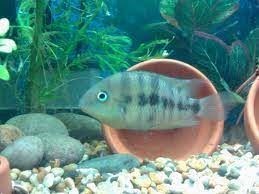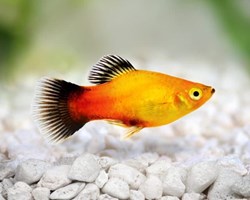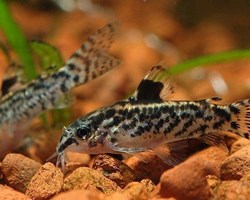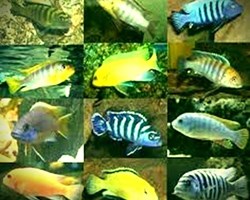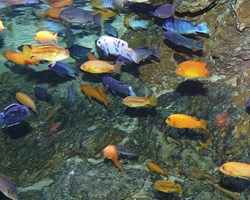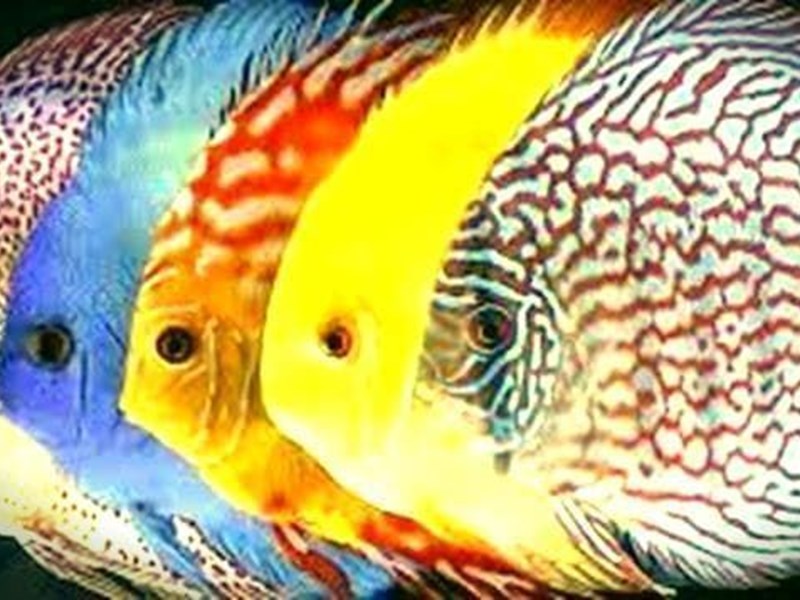
SOUTH AMERICAN CICHLIDS:
Most are small, although some grow up to 50 cm. in its natural habitat.
They are highly sought after for their varieties of shapes and colors.
Also, some fish, such as Discus, attract by their paternalistic reproductive methods.
Escalars have become a very popular species and kept in aquariums.
Most adapt well to community aquariums, even with fish of other species from different geographical origins.
ASTRONATUS OCELLATUS OR OSCAR FISH:
It comes from the Cichlidae family, it inhabits the Negro, Paraguay, Paraná and Amazonia (Brazil) rivers.
He is also known by the name Oscar.
In its natural habitat it reaches a maximum size of 25 cm.
In aquarium a little less.
It usually inhabits waters with temperatures ranging between 22 and 26º C, with a wide pH range, between 6 and 8.
Supports water hardness values of up to 25º.
The Astronatus is a carnivorous fish, which in aquariums adapts well to live or frozen food.
It also gets used to dry flake food without problems, but it is important to balance it with live food.
When it exceeds 5 or 6 cm. provide them with earthworms.
It is not recommended to invite them to populate a community aquarium.
They are aggressive with their partners, especially in the reproductive period.
Astronatus, also called "Oscar" fish, grow very quickly.
They will always need large aquariums, even if they keep small groups. They are very active and constantly dig the bottom, so it is not recommended that you have plants, they will always beat them up.
Since they generate a lot of excrement, you will need a very powerful and effective filter.
It is important to place rocks so that they spawn there in the reproductive period.
Both the male and the female take care of the eggs.

JADE EYES: ARCHOCENTRUS SPILURUS.
The Jade Eyes cichlid is native to Guatemala.
Both in its natural habitat and in the aquarium it reaches a maximum size of 12 cm.
It usually inhabits waters with temperatures ranging between 22 and 25º C, with pH values between 6.7 and 8.
The water should be soft, up to a maximum hardness of 15º. This cichlid is an omnivorous fish, and in aquariums it is better adapted to live or frozen food, such as Tubifex.
It also gets used to dry flake food without problems, but it is important to balance its diet with live food.
They can inhabit a community aquarium with other fish of a similar size.
It is peaceful in behavior and lives well in small groups.
The male is larger than the female, contrary to the general rule of nature.
The male is more colorful but the fins of the females are more rounded.
During the mating and reproduction season, they stir the bottom more frequently, so it is likely that they dig up the plants.
The female spawns in caves or in holes between rocks.
Both parents take care of the eggs and later the fry, which must be fed with vegetable food and recently hatched brine shrimp.
DISC: SYMPHYSODON SPP.:
DISCO FISH HABITAT:
It is very important to understand the natural habitat of discus to draw conclusions. Trying to imitate it will help the fish to be healthier and decide to reproduce.
The discus fish is a species of South American origin and from the Amazon River basins, Brazil and Peru.
It comes from the Cichlidae family, it is native to the Negro River, in Amazonia (Brazil).
Both in its natural habitat and in the aquarium, the discus reaches a maximum size of 15 cm.
It usually inhabits waters with temperatures ranging between 25 and 30º C, with a pH that is always acidic, between 6 and 6.5.
The water should be soft, with a hardness of 2 to 7º.
WATER PARAMETERS FOR DICOFISH:
Wild-caught discus are best found in water similar to the Amazon waters of their natural habitat.
In these places, the hardness of the water is very low.
In contrast, captive-bred discus fish have, for many generations, adapted to harsher waters.
Parameters of water for Discus fish, Amazon aquarium:
The AP .....................should be in a range of 5 to 7.5.
The Gh.....................soft water, values below 6 degrees.
The Kh.....................over 4 is an optimal value to buffer the pH.
Total absence of ammonia and nitrites and nitrates as close to zero as possible.
Regarding conductivity, values of less than 300 microsiemens would be appropriate.
The changes of season mark the conditions of the habitat, in the dry season the ambient temperature is 30°C and up to 40°C, raising the temperature of the water to 29°C or 30°C.
The pH ranges between 4.5 and 6.5 and there is practically no carbonate and other dissolved minerals in the water, so the carbonate hardness KH ranges between 0 and 2.
Six months later, during the rains, the water temperature can drop to 24°C and the conductivity can drop from 30 to 10 microsiemens in "black" water and from 200 to 80 mS in white water.
The river level rises about 12 meters during the rainy season, forming small rivers, the "Igarapés", temporary habitat in which many fish take refuge. Because of these differences in level, strong currents are sometimes formed. That's why we often see pucks in the middle of the stream.
The Discus is a carnivorous fish, which in aquariums adapts well to live or frozen food, such as Tubifex.
It also gets used to dry flake food without problems, but it is important to balance it with live food.
Discus fish are very nervous fish.
They require absolute quiet in the aquarium.
Start by locating the tank in a quiet place, away from disturbing noises or constant drafts.
Be careful when stocking your aquarium, Discus will live stressed with annoying companions like Barbus.
A good combination is to populate a very large fish tank (minimum 120 liters), with Discs and Scalars of a similar size.
It is recommended to plant abundantly some sectors of the aquarium, plants such as the Amazonian Sword or Java Ferns can be used.
DISCUS FISH CHARACTERISTICS:
Discus fish can measure up to 18cm., rounded and flat, with vast and long fins.
Their round body has 9 vertically positioned ribbons, the stress bars, which help them camouflage.
They have a tiny mouth accompanied by tiny red eyes.
With regard to the fins, the anal fin runs along the entire lower part of the animal until it reaches the ventral fin, which is triangle-shaped. The dorsal fin also travels under the body of the fish until it reaches the caudal fin.
The latter has a flattened shape like a spatula and its function is to induce swimming together with its pectoral fins.
The sex of a discus fish only knows another discus fish
Differentiating a male specimen from a female can be a bit difficult since it is necessary to study it well and become familiar with them in order to do so, because they are practically identical, only during the breeding season can we know the sex of our discus fish.

THE BEST DISCO FISH NUTRITION:
Discus fish are carnivorous fish although they do not refuse to eat food even of plant origin.
In its natural habitat, the discus feeds on other fish, snails, small crustaceans, fruits, vegetables and insects.
It can be said that he does not waste anything he can find.
During the rains, 77% of the food is organic remains and vegetable matter. 5% decapods (crustaceans), 10% mosquito larvae. 8% wood scraps.
In the dry season, the balance tips towards crustaceans and larvae and only 55% is organic debris and plant matter, since it emerges from the water and is no longer within the reach of fish.
Studies by Bleher, another disk scholar with extensive fieldwork, yield similar results, between 30% and 50% vegetative proportion depending on the season.
In an 18-cm disk, the digestive tract is about 30 cm long and 3 mm in diameter. The stomach is poorly developed. This form is representative of cichlids with a predominantly vegetable diet, based on organic remains or omnivores.
So the cow's heart, a warm-blooded mammal, is definitely not part of their natural diet and will surely cause very heavy digestion, in addition to excessively contaminating the water in the aquarium.
THE REPRODUCTION OF THE DISCO FISH:
The reproduction of Discus fish is very particular and with a medium difficulty, Discus are oviparous and form stable pairs.
Currently with average knowledge of Aquarius and some experience we can start to breed Discus fish, although they are not the easiest cichlids to reproduce, with good information we can achieve it with certain guarantees.
The female lays her eggs on flat rocks or on large smooth leaves of plants such as the Amazon Sword.
It is important to keep the pair in the aquarium, since both the male and the female take care of the fry, which feed on the layer that the parents secrete through their body.
Buy groups of young fish to form pairs by themselves.
Make sure the water filtration is very effective.
The reproductive aspect is very particular in these fish.
Discus are oviparous and form stable pairs.
The female lays her eggs on flat rocks or on large smooth leaves of plants such as Amazon Sword or Dwarf Anubias. It is important to keep the pair in the aquarium, since both the male and the female take care of the fry, which feed on the slime that the parents secrete through their bodies.
SCALARE: PTETOPHYLLUM SCALARE:
Coming from the central region of Amazonia (Brazil), it is also known by the name Angel Fish.
Both in its natural habitat and in the aquarium it reaches a maximum size of 15 cm.
It usually inhabits waters with temperatures ranging between 24 and 28º C, with pH levels between 6 and 7.5.
The aquarium water should be soft, with a maximum hardness of 15º.
GEOGRAPHICAL DISTRIBUTION OF THE SCALAR OR ANGEL FISH:
We find it in South America, along the Amazon basin and its respective tributaries.
Depending on the biotope or area in which the pterophyllum scalare is found, it shows a coloration and adaptation to the environment, emerging subspecies of which we will discuss in more detail in another article, since their care is more demanding than the common scalar.
The scalar, in its natural habitat, is found among the branches and leaves of the riverbanks, hidden on the lookout for its prey or defending its eggs.
Normally in calm waters and characterized by an amber color due to the large presence of tannins due to the decomposition of leaves, branches, seeds...
DESCRIPTION OF THE SCALAR FISH OR PTEROPHYLLUM SCALARE:
The Escalar fish or Angel fish is the reason for the initiation of many fans because with its smooth movements and its suspended figure in the middle of an aquarium, it transmits serenity and harmony to the fan.
Regarding taxonomy, we have three varieties within the same species: pterophyllum scalare, altum or leopoldi.
Regarding the physiognomy, it has a laterally flattened body and notorious dorsal and anal fins that prevail over the rest, the ventral ones. These fins, almost filiform, extend to the height of the anal fin or somewhat less.
In its wild state, it is grayish green with silver reflections, 4 vertical dark stripes, in its adult state (7 in juveniles), whose greater or lesser coloration will depend on the mood of the scalar.
For the latter, when there has been some type of confrontation in an aquarium with a school of scalars, we will see some very marked stripes as it is one of the symptoms that appear when they make their great character known to the rest.
The size is between 14-16 cm, from mouth to tail, without varying from male to female in height.
However, it can reach 20-22 cm in height.
The largest species is the scalar altum that exceeds 30 centimeters in height and requires aquariums with a water column greater than 60-70 centimeters.
The Escalar is an omnivorous fish, which in aquariums adapts well to dry food in flakes or granules.
Their diet is supplemented with live or frozen food, such as Tubifex. T
He also balances his diet with peas or small pieces of fresh lettuce.
Its behavioral characteristics, both in nature and in the aquarium, are very similar to those of the Discus.
Their main difference is in the reproductive period, in which the Scalars could eat their own eggs under conditions of stress or danger of other fish doing so.
Since it is very difficult to distinguish the sexes, it is recommended that you acquire groups of young specimens so that they naturally mate.
They spawn on smooth rocks or leaves of plants such as the Broad-leaved Amazon Sword (Echinodorus paniculatus).
SCALAR FISH FEEDING:
We can feed it with a wide variety of dry food, although due to its protein preference, we should often feed it with brine shrimp, red or black mosquito larva, tubifex, etc.
It is also advisable to provide dry vegetable food as this improves the color.
WATER PARAMETERS FOR SCALING:
Scalars or Angel fish are resistant fish as long as they are in their ideal conditions:
Temperature: 25-26ºC
Ph: 6.5-7
Kh: 2-3
Gh: Around 10.
REPRODUCTION OF THE SCALAR OR ANGEL FISH:
Once we have a pair of adult scalars, we can separate them into an 80 to 150 liter aquarium (although we can also leave the pair in the normal aquarium and when they lay, we separate them and take care of them ourselves).
In community aquariums they need some experience until they make a bet. At the slightest threat they will eat the spawn.
If we separate the couple to a specific aquarium we have two options, either let the parents take care of the laying, or separate the eggs once laid to a smaller aquarium.
Firstly, most of the time they will lay on a wide leaf or flat stone. Later, the parents themselves will be in charge of aerating the eggs (bear in mind that the clutches are very large, and can reach up to 300 eggs), until after 3-4 days they will hatch.
At this time the hatchlings will remain glued to the surface where they have spawned and after a couple of days we will see the hatchlings swimming freely.
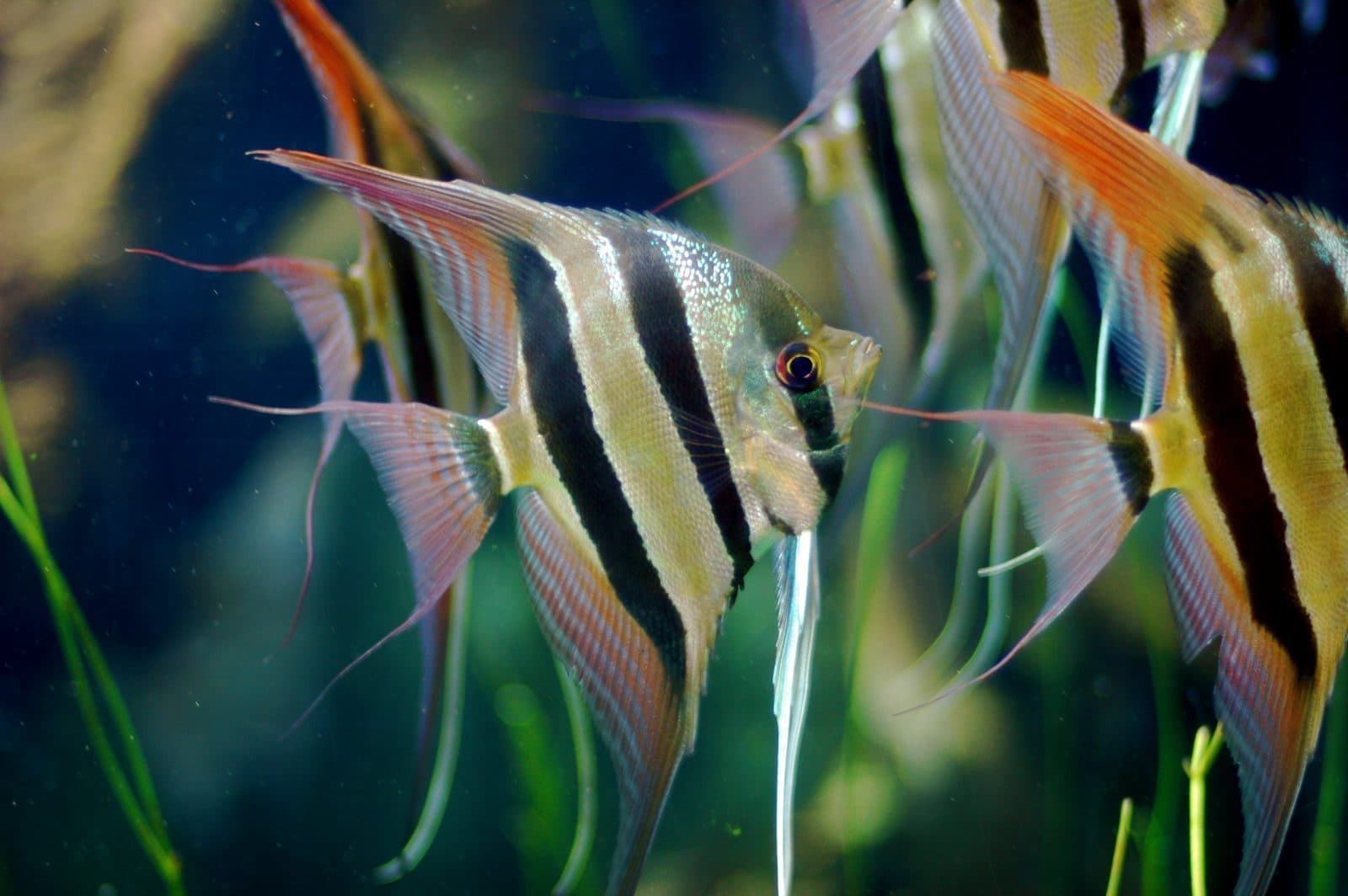
THE AMAZON CICHLIDS:
Most of the Amazonian aquarium cichlids are highly sought after for their variety of shapes and colors, being classified as the most beautiful freshwater fish in the world.
Choosing fish that look nice and are suitable for your aquarium can be a bit overwhelming, especially if you are new to aquariums.
The Amazon aquarium and its inhabitants have enormous diversity.
In the stores you will find hundreds of species, which with a little information about the chosen species will correctly recreate the underwater world of the Amazon in the home aquarium.
Amazonian fish usually grow quite freely, in our aquariums not so much, but they usually have a good size, most Cichlids reach a size between 5 cm and 30 cm inside the aquarium.
We will find the large cichlids with sizes of 10cm. at 30cm. and the small 5cm dwarf cichlids. up to 10cm., ideal for medium aquariums, we can choose between different sizes.
A good diet for our cichlids should be as rich and varied as possible, we must give them the right amount at each feeding, without going overboard, we must remember that Amazonian cichlids in their natural habitat have a lot of space to swim and in some way they exercise This is very limited in aquariums, so we will feed them properly.
THE BEST NUTRITION FOR AN AMAZON CICHLID:
Carnivorous cichlids are those that obtain all the necessary nutrients from the meat of some animal, some small fish, a crustacean, some insect that they find in their habitat.
The herbivorous cichlids are the ones that obtain most of the essential nutrients for their development from plant origin, they can also eat some crustacean in the vegetation and from there they get part of the necessary proteins.
In the omnivorous cichlids we will find most of the species since they eat everything, both as food of plant and animal origin.
RAMIREZI OR PAPILOCHROMIS RAMIREZI:
The Ramirezis are members of the Cichlidae family, they are native to Colombia and Venezuela.
It is a fish with a stylized body endowed with color and a lot of character among members of the same species.
It will move through the lower-middle zone of the aquarium.
Due to its calm character, it is highly recommended for community aquariums and medium-sized Amazonian aquariums.
It comes from the East, a member of the Cichlidae family, it is originally from Colombia and Venezuela.
It usually inhabits waters with temperatures ranging between 22 and 27º C, with a pH that is always acidic, between 6 and 7.
The water should be quite soft from 3 to 7º.
The Ramirezi is omnivorous, in aquariums it adapts well to dry food.
If it is not supplemented with live or frozen food, such as Tubifex, its color quickly loses intensity.
Both in its natural habitat and in the aquarium it reaches a maximum size of 7 cm.
The Ramirezi, apart from being peaceful, is somewhat fearful.
Do not set up a community aquarium with dozens of species, it will suffice to accompany it with a few fish from its natural habitat.
You can opt for Characins like the Neon, the Diamond Tetra or the Lemon Tetra, also some Ax fish.
You will need to have densely planted sections of the aquarium for security. Include flat rocks for them to spawn on. Both females and males take care of eggs and fry.
The Ramirezi, apart from being peaceful, is somewhat fearful. You will need to have densely planted sections of the aquarium for security. Include flat rocks for them to spawn on. Both females and males take care of eggs and fry.
COMMON NAME Cichlid ramirezi
SCIENTIFIC NAME Microgeophagus ramirezi
FAMILY Cichlids
ORDER Perciformes
CHEMICAL PARAMETERS Temperature: 23ºC-28ºC // PH: 6.0 to 6.5 // GH: 5ºd to 10ºd. //
AQUARIUM > 50 lt. substratum of fine gravel and abundant vegetation, caves and hiding places formed by rocks, trunks and roots.
BIOTOPE In the savannah known as Los Llanos in different types of water, although preferably in flooded areas with little current. GEOGRAPHICAL ORIGIN South America: Orinoco River Basin. Venezuela, Columbia.
MORPHOLOGY Size: Up to 7.5 cm. Coloration: Body blue, orange red on the forehead. Sexual dimorphism: Yes
FOOD Omnivore, in aquariums it adapts well to commercial food.
BEHAVIOR Monogamous, calm, except in breeding season.
LIFETIME 3 years
REPRODUCTION Oviparous.
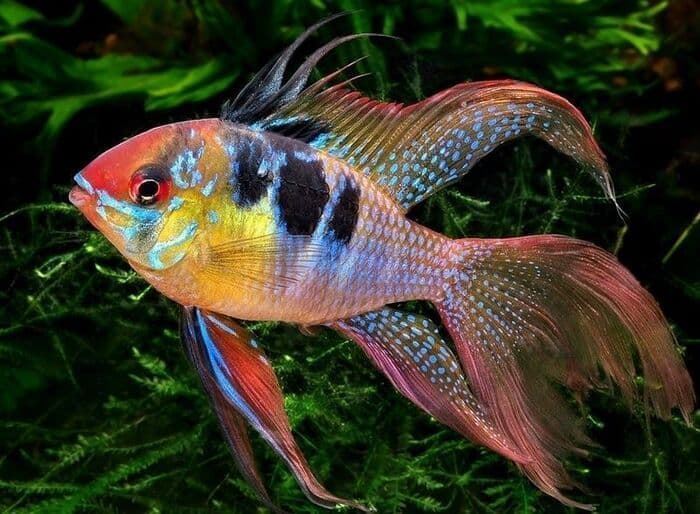
ELECTRIC BLUE RAMIREZI:
The electric blue Ramirezi is a beautiful fish that can be found throughout the Orinoco River Basin.
Within Venezuela in the Amana, Palenque, Guariquito and Guarico rivers, and in Colombia in the Meta and Vichada rivers.
Electric Blue Ramirezi Token
COMMON NAME Electric Blue Ramirezi Cichlid
SCIENTIFIC NAME Microgeophagus ramirezi
FAMILY Cichlids
ORDER Perciformes
CHEMICAL PARAMETERS Temperature: 23ºC-28ºC // PH: 6.0 to 6.5 // GH: 5ºd to 10ºd. //
AQUARIUM > 50 lt. substratum of fine gravel and abundant vegetation, caves and hiding places formed by rocks, trunks and roots.
BIOTOPE In the savannah known as Los Llanos in different types of water, although preferably in flooded areas with little current. GEOGRAPHICAL ORIGIN South America: Orinoco River Basin. Venezuela, Columbia.
MORPHOLOGY Size: Up to 7.5 cm. Coloration: Body blue, orange red on the forehead. Sexual dimorphism: Yes
FOOD Omnivore
BEHAVIOR Monogamous, calm, except in breeding season.
LIFETIME 3 years
REPRODUCTION Oviparous.
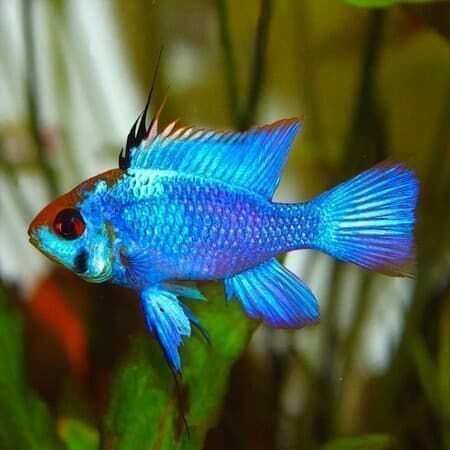
RAMIREZI ELECTRIC BLUE RED HEAT :
The Blue Red Heat Ramirezi is a calm fish, except in breeding seasons, when it can become more aggressive with other fish.
Its reproduction is similar to that of any dwarf cichlid with spawning habits in open spaces.
Ramirezi Token Electric Blue Red Heat
COMMON NAME Electric Blue Ramirezi Cichlid Red Heat
SCIENTIFIC NAME Microgeophagus ramirezi
FAMILY Cichlids
ORDER Perciformes
CHEMICAL PARAMETERS Temperature: 23ºC-28ºC // PH: 6.0 to 6.5 // GH: 5ºd to 10ºd. //
AQUARIUM > 50 lt. substratum of fine gravel and abundant vegetation, caves and hiding places formed by rocks, trunks and roots.
BIOTOPE In the savannah known as Los Llanos in different types of water, although preferably in flooded areas with little current. GEOGRAPHICAL ORIGIN South America: Orinoco River Basin. Venezuela, Columbia.
MORPHOLOGY Size: Up to 7.5 cm. Coloration: Body blue, orange red on the forehead. Sexual dimorphism: Yes
FOOD Omnivore
BEHAVIOR Monogamous, calm, except in breeding season.
LIFETIME 3 years
REPRODUCTION Oviparous.

RAMIREZI GOLD :
The Ramirezi Gold or Golden Ramirezi is a small-sized fish from the American cichlid family, it is peaceful so it can be kept in community aquariums.
It can be raised in aquariums with enough space and surfaces to lay the eggs, such as smooth stones or plants with large leaves. Compatible with tetras, corydoras or ancistrus.
Ramirezi Gold Token
COMMON NAME Golden ramirezi cichlid
SCIENTIFIC NAME Microgeophagus ramirezi
FAMILY Cichlids
ORDER Perciformes
CHEMICAL PARAMETERS Temperature: 23ºC-28ºC // PH: 6.0 to 6.5 // GH: 5ºd to 10ºd. //
AQUARIUM > 50 lt. substratum of fine gravel and abundant vegetation, caves and hiding places formed by rocks, trunks and roots.
BIOTOPE In the savannah known as Los Llanos in different types of water, although preferably in flooded areas with little current. GEOGRAPHICAL ORIGIN South America: Orinoco River Basin. Venezuela, Columbia.
MORPHOLOGY Size: Up to 7.5 cm. Coloration: Body blue, orange red on the forehead. Sexual dimorphism: Yes
FOOD Omnivore
BEHAVIOR Monogamous, calm, except in breeding season.
LIFETIME 3 years
REPRODUCTION Oviparous.
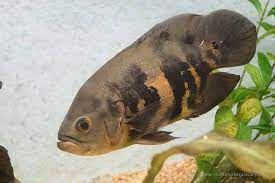
BLACK RAMIREZI:
The black Mikrogeophagus Ramirezi lives in the Orinoco River Basin, in Venezuela and Colombia.
It is a fish with a stylized body endowed with intense color and a lot of character among members of the same species.
Black Ramirezi Token
COMMON NAME Black ramirezi cichlid
SCIENTIFIC NAME Microgeophagus ramirezi
FAMILY Cichlids
ORDER Perciformes
CHEMICAL PARAMETERS Temperature: 23ºC-28ºC // PH: 6.0 to 6.5 // GH: 5ºd to 10ºd. //
AQUARIUM > 50 lt. substratum of fine gravel and abundant vegetation, caves and hiding places formed by rocks, trunks and roots.
BIOTOPE In the savannah known as Los Llanos in different types of water, although preferably in flooded areas with little current. GEOGRAPHICAL ORIGIN South America: Orinoco River Basin. Venezuela, Columbia.
MORPHOLOGY Size: Up to 7.5 cm. Coloration: Body blue, orange red on the forehead. Sexual dimorphism: Yes
FOOD Omnivore
BEHAVIOR Monogamous, calm, except in breeding season.
LIFETIME 3 years
REPRODUCTION Oviparous.
